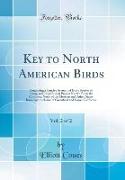- Start
- Key to North American Birds, Vol. 2 of 2
Key to North American Birds, Vol. 2 of 2
Angebote / Angebote:
Excerpt from Key to North American Birds, Vol. 2 of 2: Containing a Concise Account of Every Species of Living and Fossil Bird at Present Known From the Continent North of the Mexican and United States Boundary, Inclusive of Greenland and Lower CaliforniaWith this sketch of some leading features of the group (it will enable the student to recog nize any Picarian bird of this country at least, and that is my main object), I pass to the consideration of its subdivision, with the remark that a precedent may be found for any con ceivable grouping of the families that is not perfectly preposterous, and for some arrangements that are nearly se. As well as I can judge from the material at my command, and relying upon authority for data that I lack, the provisional arrangement adopted in the 2tl - 4th editions of the Key must be entirely remodelled. Such is especially the case With the Cuculiform Picarians, Which I justly stigmatized (p. 446) as a mixed lot requiring to be reconstructed by exclusion of some of the families given as entering into its composition. There are at least 24 Picarian families, seven of them North American, roughly divisible into three groups or series, which I formerly called Cypsehformes, Cucul'zfownes, and Piciformes, answering to the Cypselomorphdf, Coccygomorphw, and Celeomorphw of Huxley, or the se-called orders ¿iacrochires, Coccyges, and Pici ofthe A. O. U. But I am now satisfied that we can best im prove npon these divisions by effacing their alleged boundaries and remapping the 24 families by redistributing them directly into several more than three snbonlers or superfamilies. Such can be satisfactorily established, primarily upon strong anatomical grounds. Secondarily upon good external characters. The structural modifications most serviceable for classification are presence or absence of the ambiens muscle, the disposition of the digits and especially of their ¿exer tendons, conformation of the bony palate, sternum, and bones of the wing, presence or absence of colic czeca, as curiously related to the condition of the elzeodochon, and various peculiarities of the pterylosis, such as the presence or absence of aftershafts, pnlviplnmes, ancl tuft on the oil-glaml, condition of the dorsal and ventral tracts, number of relniges and rec trices, etc. The arrangement of the carotid arteries is also to be taken into account. Details ofexternal form are insignificant in comparison with such morphological characters as those just indicated, and may even be deceptive, for the superficial resemblance is slight between some closely related families, and conversely. Thus, the great helmetw] llornbills are specially related to the small slender-hilled lluulmes, the Toucans, with their enormous hills, belong to the series which includes the Barbets, l'nll'-birds. Jacamars, and and other such instances Could be citml.About the PublisherForgotten Books publishes hundreds of thousands of rare and classic books. Find more at www.forgottenbooks.comThis book is a reproduction of an important historical work. Forgotten Books uses state-of-the-art technology to digitally reconstruct the work, preserving the original format whilst repairing imperfections present in the aged copy. In rare cases, an imperfection in the original, such as a blemish or missing page, may be replicated in our edition. We do, however, repair the vast majority of imperfections successfully, any imperfections that remain are intentionally left to preserve the state of such historical works.
Folgt in ca. 10 Arbeitstagen




